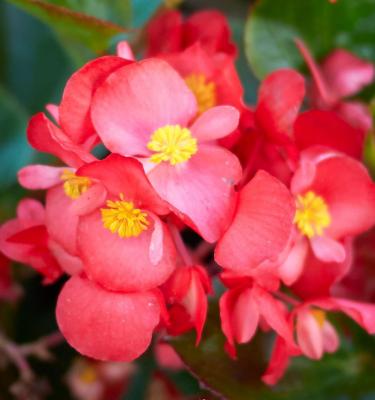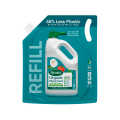

The Ultimate Guide to Growing Begonias
Begonias come in a range of sizes and forms, and they’re loved by gardeners as indoor or outdoor plants for their colourful flowers and patterned leaves. There is a begonia to suit nearly every garden situation! To understand how diverse and varied begonias are, here’s some information about 5 of the most common species:
Tuberous begonias (Begonia x tuber hybrida) - tuberous begonias are grown for their amazing flowers in shades of white, cream, yellow, orange, pink, red and even bi-colours. You’ll get the biggest and best flower displays if they are planted in a filtered sun position. They can be grown in the ground or in pots. They’ll flower throughout spring and summer and die back in autumn/winter for their dormancy period.
Bedding begonias (Begonia semperflorens) - given the right conditions bedding begonias will flower year round. They do not tolerate frost and prefer a full sun position. Mass plant them for colourful displays in your garden or plant them into pots where they’ll quickly fill it with colour.
Cane begonias (Begonia coccinea) - these begonias, as the name suggests, have a long cane growth habit and can reach up to 2 metres tall! But they look great in pots if given some support. Many cane begonias have highly patterned leaves and long lasting flowers. Best in a semi-shaded spot, away from afternoon sun.
Rex begonias (Begonia rex-cultorium) - rex begonias have the loudest and most unusual foliage. Rex begonia foliage comes in green, black, pink, silver, black, purple - some with metallic hints to them! The leaves can have spots, stripes, whorls or splotches. These begonias prefer a bright light, but shaded spot away from direct sunlight.
Elatior begonias (Begonia x hiemalis) - the Elatior begonias have green, heart shaped leaves and brightly coloured flowers. These short-lived begonias prefer a moist, warm climate and are normally grown as indoor plants or outdoors in bright, but full shade.
Top tips for growing begonias
- Most begonias prefer a part shade or bright shade position, but some, like the bedding begonias thrive in full sun.
- Begonia’s prefer a slightly acidic soil, so use fertiliser and potting mix (if growing in pots) that’s designed for acid loving plants.
- Begonias need a moist soil that is free draining. Soggy or waterlogged soil is particularly troublesome for begonias with tubers or rhizomes underground that will quickly rot if they are too wet.
- Begonias will happily grow in pots, just use a suitable potting mix like Scotts Osmocote Rose, Gardenia, Azalea & Camellia Mix and get a pot with good drainage.
- Fertilise in spring, summer and autumn with Scotts Osmocote Plus Organics Roses, Gardenias & Azaleas Plant Food & Soil Improver - if you live in a warm climate where begonias actively grow over winter, they can be fed then too.
Essential shopping list for growing begonias
- A begonia plant
- Scotts Osmocote Plus Organics Roses, Gardenias & Azaleas Plant Food & Soil Improver
- Scotts Osmocote Compost Premium Soil Improver
- Garden Shovel
- If growing in pots, you’ll need Scotts Osmocote Rose, Gardenia, Azalea & Camellia Mix + Scotts Osmocote Controlled Release Fertiliser: Roses, Gardenias, Azaleas & Camellias and a suitable pot or container
- Defender Pyrethrum Insect Spray
- Defender Snail & Slug Pellets
- Mulch
Preparation
Most begonias prefer a part or semi shaded spot - depending on the species you’ve chosen. Most begonias can be grown as indoor or outdoor plants - growing begonias indoors is particularly handy if you live in a frost prone climate. Begonias prefer a moist, but free draining soil that’s slightly acidic with a pH around 5.5 - 6.0.
Prepare the soil for planting begonias by mixing Scotts Osmocote Compost Premium Soil Improver and Scotts Osmocote Plus Organics Roses, Gardenias & Azaleas Plant Food & Soil Improver through the soil in your chosen area.
Growing begonias in the garden
Plant your begonia into prepared soil - dig the hole twice as wide as the original pot and the same depth. Gently remove the begonia from the nursery pot and tease the roots lightly if they’re compact.
Pop the begonia into the hole and backfill around the plant. Water in well. Mulch around the base of begonias to retain moisture and suppress weeds.
Growing begonias in pots
Begonias can be grown in pots or planters with good drainage - choose a pot that’s at least twice as wide and deep as the original nursery pot (or even larger if you want to cluster your begonias for a larger scale display).
Fill your pot or planter with Scotts Osmocote Rose, Gardenia, Azalea & Camellia Mix. Gently remove the begonia from the nursery pot and tease the roots lightly if they are compact. Plant the begonia into the potting mix and backfill around the plant. Water in well.
If your potted begonia is to be an outdoor plant, mulch lightly over the surface of the potting mix to help retain moisture, but keep the mulch back from the plant's main stem.
How to care for begonias
Begonia will need fertilising in spring, summer and autumn with Scotts Osmocote Plus Organics Roses, Gardenias & Azaleas Plant Food & Soil Improver when they are actively growing. If you’re growing begonias in pots fertilise with Scotts Osmocote Controlled Release Fertiliser: Roses, Gardenias, Azaleas & Camellias.
If you live in a warm, humid climate where begonias will continue growing over winter you can also fertilise them then.
Regularly deadheading spent flowers or removing yellowing leaves will encourage new growth on your begonia.
Common begonias pests and diseases
Slugs and snails can cause unsightly damage to the leaves and flowers of begonias. If needed use beer traps (saucers filled with beer) or sprinkle around some Defender Snail & Slug Pellets to control these pests.
If you notice distorted new growth, aphids may be infesting your begonias. Spray aphids with Defender Pyrethrum Insect Spray to control them.
Begonias are also susceptible to powdery mildew - this fungal disease leaves a white/powdery residue on the leaves and can eventually kill your plants. Avoid overhead watering that wets the leaves and look to increase airflow around your begonias to help prevent powdery mildew outbreaks.



